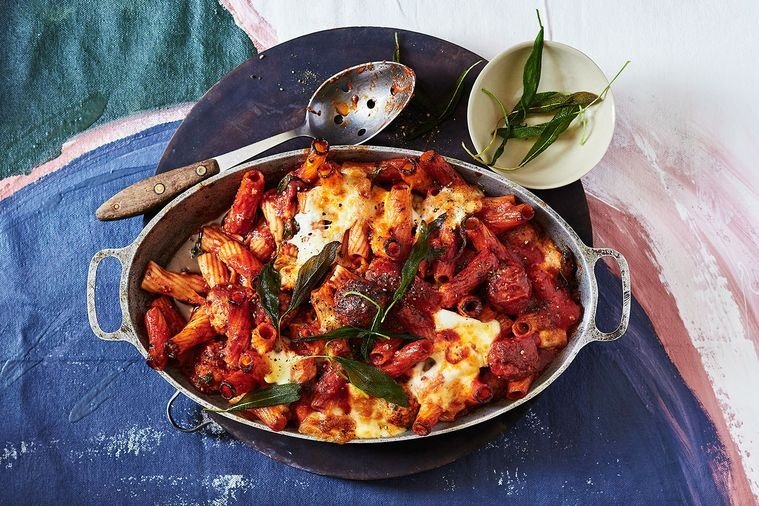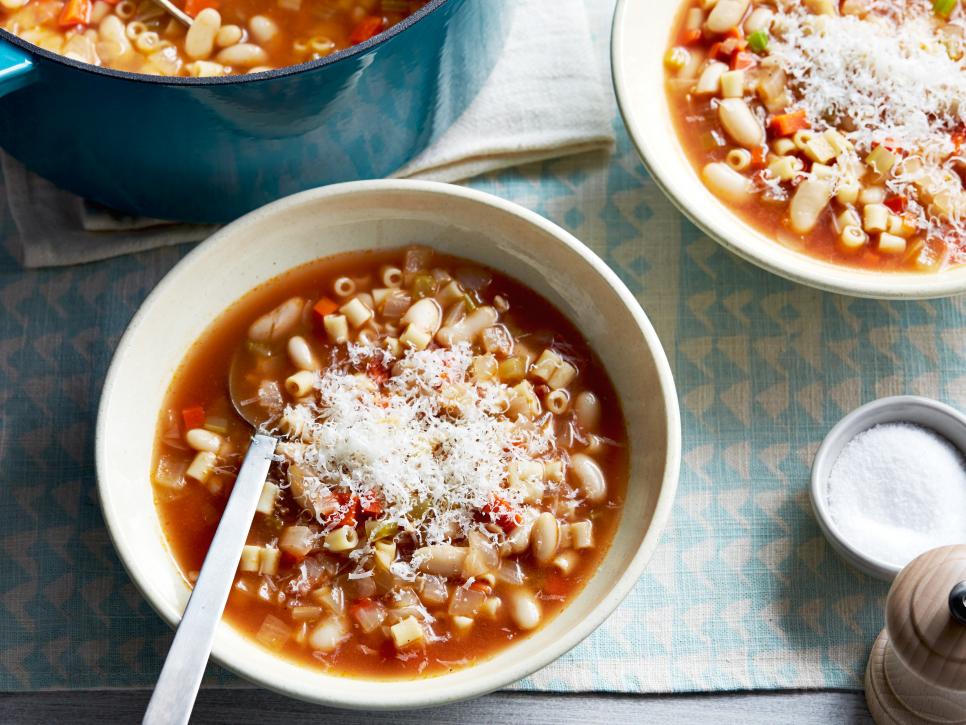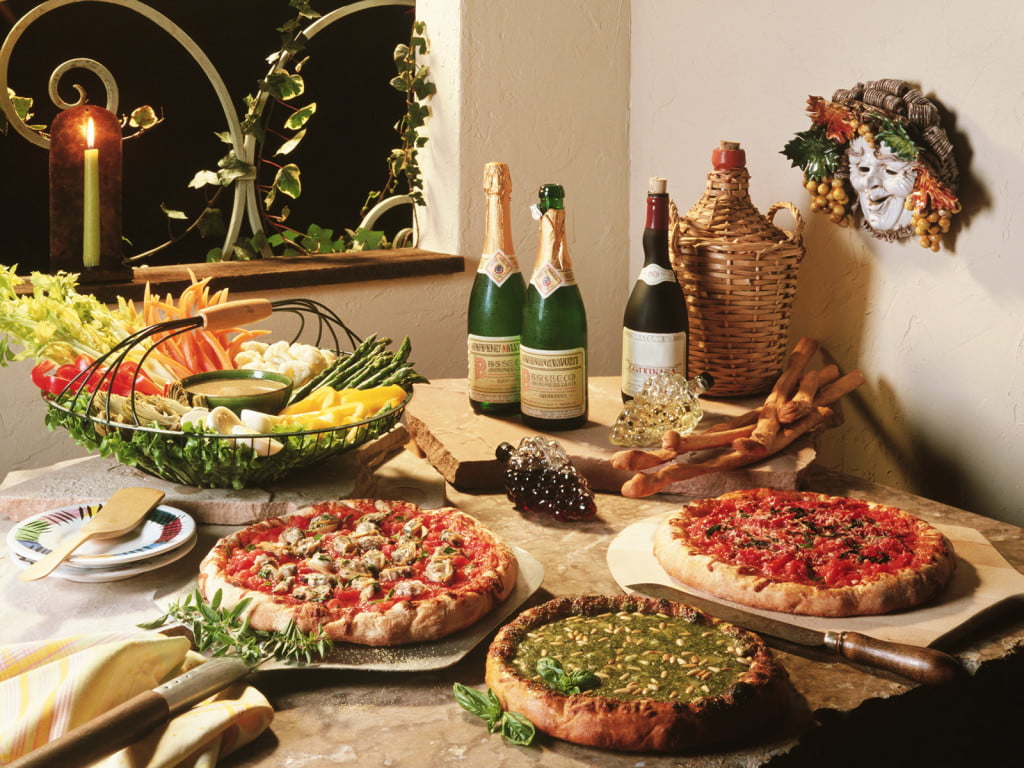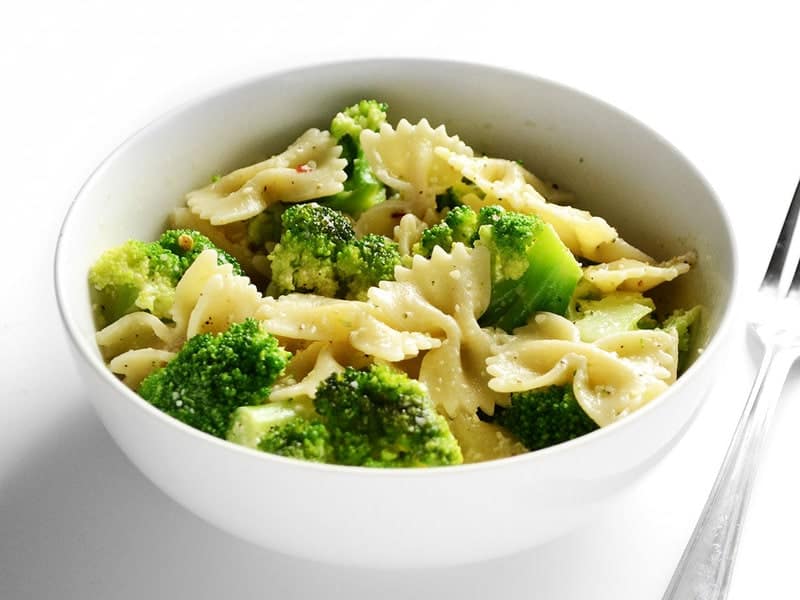1. Pizza
A traditional pizza Margherita of Naples, complete with the thick crust. Photograph by Amanda Ruggeri
Though a slab of flat bread served with oil and spices was around long before the unification Italy, there’s perhaps no dish that is as common or as representative of the country as the humble pizza. Easy, cheap, and filling, pizza has long been a common snack or meal, especially in Naples where tomato sauce was first added. When the Italian Queen Margherita came through the bustling city on a tour of her kingdom in 1889 she asked to try this dish that she saw so many of her subjects eating. A local entrepreneur served her the now legendary combination of tomato sauce, mozzarella, and basil, creating (or more likely, branding) the Margherita pizza. Whether by coincidence or design, the Margherita also displays the colors of the Italian flag.
Today, there are essentially two types of pizza to choose from in Italy: Neopolitan-style pizza, or Roman-style pizza (though to be honest, many delivery places exist that is a happy medium between the two). Neapolitan-style pizza has a thick, fluffy crust. It tends to be a little smaller in diameter because the dough hasn’t been rolled out as far and it’s more filling. Roman-style pizza is has a paper-thin crust and just the slightest crunch (you don’t want it to be soggy!) It’s larger in diameter but typically lighter and less of a gluten bomb.
Because of Naples’ history with Queen Margherita, the city claims to be the birthplace of modern pizza, although the point is debated throughout Italy. Whatever the case may be, the general rule for ordering pizza in Italy is to shoot for fewer toppings. You should also be skeptical of any pizzerias that load the toppings onto their pies – this can often be a tactic used to cover up the use of poor ingredients. Fewer toppings are a sign of confidence in the product because each topping has to be exemplary. Whichever pizza you might favor, the other rule of thumb is: When in Rome, do as the Romans do, i.e., eat Roman style pizza. When in Naples, naturally, do as the Neapolitans do.
2. Bottarga
Smoked eggs from the rat of the sea. Wait, what? Don’t be put off by this rough description on an Italian delicacy because the other way to describe bottarga is “Sicilian Caviar”. In August and September southern Italians take the roe from gray mullets, salt it, press it, and then leave it to air dry for six months. The result is a solid hunk of eggs the color of amber and blood oranges that, when sliced and eaten or grated over pasta, blossoms into a gloriously savory, smoky, and briny bouquet. Though essentially a poor man’s answer to preserving seafood in the days before refrigeration, it is now considered one of the most sought after and luxurious foodstuffs in Italy, right up there with truffles (more on those later). We recommend it grated over pasta, or simply sliced thinly and drizzled with lemon juice and olive oil.
3. Lasagna
A good lasagna requires exemplary pasta, ragu and bechamel. | Photo by Mike Easton of ilcorvopasta.com/
Lasagna is a wide, flat pasta noodle, usually baked in layers in the oven. Like most Italian dishes, its origins are hotly contested, but we can at least say that’s its stronghold is in the region of Emilia-Romagna, where it transformed from a poor man’s food to a rich meal filled with the ragù, or meat sauce.
4. Fiorentina Steak
A bistecca fiorentina, or Florentine T-bone steak, covers all of the characteristics of Italy’s best dishes: a specific cut of meat from a specific cow prepared in a very specific way all within the confines of a specific region.
5. Ribollita
While on the topic of Tuscany, we would be remiss if we didn’t mention this hearty soup which has become so popular Campbells makes a (not amazing) version. With roots in the peasant cooking of the region, this vegetable soup is thickened with bread instead of meat, because that is what was cheaper and more readily available for hundreds of years in the desperately poor Italian countryside. In Tuscany, the dish is considered a special treat in the autumn, when the taste of the harvest vegetables is at its most vibrant and the soup explodes with an intense savoriness despite the absence of meat (at least in the traditional versions). Often eaten as a first course instead of pasta in the trattorie of Florence, this is one hearty stew that shows off the immense, and often untapped power of great produce.
6. Polenta
Although we tend to associate pasta with all of Italy, the truth is that until fairly recently, the staple starch eaten in the northern parts of the boot was polenta. This corn mush, which is nearly identical to the grits eaten in the southern states of America (variations are down to the coarseness or fineness with which the kernels of corn are ground), was originally made from whatever starches were handy, including acorns and buckwheat. However, the introduction of corn to Europe in the 16th century saw it become the dominant ingredient of polenta. Although it lacks the diversity in shapes and textures that pasta has, polenta is the perfect accompaniment to a wide range of meats, especially stewed meats, and it is arguably one of the most comforting foods you can eat when the temperatures drop in cities like Milan, Turin, and Venice. Look for it as a mush, or packed and fried into wobbly fritters. You should also not miss it in the next dish…
7. Ossobuco
Ossobucco alla milanese atop a fragrant mound of risotto alla milanese is the most classic dish you can eat in Milan.
The world-famous ossobuco alla milanese is a bone-in veal shank, cooked low and slow until meltingly tender in a broth of meat stock, white wine, and veggies. Traditionally, it’s accompanied by a gremolata(lemon zest, garlic, and parsley) but that’s optional. Although the Milanese like to claim this meaty masterpiece there are as many versions of it as there are nonnas in Lombardy, which is known for hearty, often rustic dishes that are good at coating the ribs and staving off the winter chill. Despite the popularity of ossobuco (which literally means ‘hollow bone’), it’s not always common to see it on restaurant menus because it needs about three hours of cooking time. If you do get a chance to eat it in a restaurant or home, or even to cook it yourself, you should jump at the opportunity. It’s usually accompanied by polenta or the next item on our list.
8. Risotto
Risotto requires a lot of stock and a lot of stirring. | Photo by Luis Rocha via Flickr
Rounding out the holy trinity of Italian starches is rice, which is often eaten as the creamy, luxurious risotto. Ironically, Italians aren’t huge rice eaters, what with all the pasta and the polenta, but they are the largest producers of rice in Europe. While southern Italy is often called the country’s bread basket, Northern Italy, especially Lombardy and Piedmont, are its rice bowl. It’s fitting then, that the Arborio and Carneroli varieties grown in the vast rice paddies of these regions are turned into one of Italy’s most iconic dishes by being mixed with stock and stirred until they form a velvety semi-soup that perfectly conveys the flavors of anything cooked with it. The most famous type of risotto is probably the saffron-infused risotto alla milanese, which was invented, according to legend, by the workmen building the Milan Cathedral who were using saffron to dye the stained glass windows and figured they would also throw it into their rice. Other classic versions of the dish include risotto al nero di sepia (with cuttlefish and ink) and risi e bisi (with pancetta and peas), both of which hail from Venice.
9. Carbonara
It is possible to go to Italy and never eat anything besides pasta. We know because we’ve done it. But if there is one bucket list pasta that everyone should try at least once, our vote goes to carbonara (we know this is controversial – feel free to leave your desert island pasta in the comments). This dish is deceptively simple – spaghetti, eggs, pecorino cheese, cured guanciale, and black pepper – but takes a lifetime to master and a good version will change your life. There are many imitations – namely, those that thicken their sauces with cream or use bacon instead of guanciale – but accept no substitutes because the difference in taste is enormous. This is a Roman specialty but even in the capital there are still plenty of restaurants that can and do get it wrong. The best way to ensure you are served an exemplary version is to get a recommendation from a local. You are not looking for simply a good restaurant, but a restaurant that specifically serves a great carbonara.
10. Truffles
Ah, truffles. This pungent, elusive fungus is one of the most expensive and coveted foods in the world – and Italy is one of the few countries where they can be found in abundance! Grown only in the wild, this tuber is found by hunting the forests and mountains of Umbria and Piedmont with dogs or pigs trained to smell it underground.
11. Focaccia (and other bread)
‘Pane Sardo’, pictured on top, is a thin Sardinian bread known locally as “music bread”. | Photo by marco_ask @Flickr
There are hundreds of types of bread in Italy, and the best one is the one baked locally that morning, wherever you happen to be staying. But you shouldn’t leave without trying at least a few of the various types that Italy’s robust baking culture has developed over the years.
For example, you might notice that bread in Tuscany has a different taste than it does elsewhere. That’s because it’s made without salt. This is a tradition that originated in feuds between Tuscany and the coastal regions that controlled the salt trade and had no problem cutting off the agricultural region from its supply of the once-valuable commodity. To this day Tuscan bread is best eaten with a drizzle of olive oil and herbs or salt.
Liguria is the home of the world-famous flat bread, focaccia. Reminiscent of a thick pizza dough, classic focaccia is hyper-salty, drizzled with olive oil and basically irresistible either by itself, or made into a sandwich. It’s often served open faced, with toppings like rosemary, zucchini, cheese, and olives.
Off the coast of Italy, in Sardinia, the classic bread doesn’t look much like bread at all, instead appearing much more like a pita. Pane carasau, was named for the word carasare, which means to toast. Unsurprisingly, this bread paper-thin bread it always toasted after baking, giving it its wonderful crunch!
We can’t tell you which style of bread you are going to enjoy the most but we can tell you that you should never turn down the opportunity to taste a new type. From the biggest cities to the smallest towns, you are never far from an Italian bakery, so stop by and pick up a few loaves whenever you have a chance.
12. Arancini & Supplì
Our Sicilian friends will be having some stern words with us for combining their beloved arancino with it’s Roman cousins, supplì, and vice versa but the fact remains that when in Italy you should try at least one type of freshly-fried rice ball. These starch bombs appear in bars, restaurants, and market stalls all over Italy, but if you are going to order one, it helps to know the difference. The Sicilian arancino is often larger, and either conical or circular in shape. In fact, its name means “small orange.” It is typically filled with ragu and some sort of cheese, with optional veggies like peas, mushrooms, or eggplant. You will also find specialty arancini like carbonara, though purists tend to turn up their noses at these newfangled inventions. Supplì are a Roman specialty usually found in pizzerias and as antipasti. They are oblong in shape and traditionally contain only rice, tomato sauce, and a large piece of mozzarella in the middle. Their nickname – “telephones” – comes from the idea that when you break them in half a thin chord of molten cheese should connect the two ends. Although fried balls of rice are prevalent all over Italy (and America for that matter) they are often fried in advance and left under heat lamps. If you want one that’s a cut above the rest make sure it’s fried when you order it – the difference is night and day.
13. Coffee
For coffee drinkers, there’s little better than enjoying a coffee in Italy.
Just remember, Italian coffee isn’t like coffee in your local Starbucks. Though some of the dozens of choices might sound similar (latte… anything that finishes in –puccino, etc.) they are rarely what you have been led to believe they are. For instance, if you were to order a ‘latte,’ in Italy you would simply be served a glass of milk.
14. Gelato
No trip to Italy is complete without gelato! If you’re tempted to have a scoop (or two) a day don’t worry, it’s totally normal to eat gelato on a regular basis in Italy, especially in the summer.
Though gelato translates to ‘ice cream,’ it’s not quite the same. By law, gelato has far less butterfat than ice cream: about 4 to 8 percent compared to 14 percent for ice cream in the United States. The low-fat content means that gelato is served a bit warmer and tends to melt in your mouth faster, it also intensifies the flavor and gives it a more velvety texture.
Second, gelato has a much higher density. Regular ice cream has air and water added to increase volume and weight. Unfortunately, these additions also make it less flavorful. This practice is illegal in Italy, leaving gelato (at least, traditional artisan gelato) super sweet and super flavorful. Finally, good gelato isn’t made for long-term storage.
So how can you know if it’s the good stuff or not? When seeking out fresh, artisanal gelato there are a few things to look out for. Before purchasing, check out the color (is it natural or neon bright?), if the fruit flavors are in season (they should be), and if there is an ingredient list on display. Also, check out how it’s stored. Artisanal gelato is slow-churned and often, though now always stored in covered, circular containers. Those heaping trays of wavy-topped gelato might look pretty, but they have also been whipped to adding more air to the product.
15. Tiramisu
If you want to branch out from gelato in the world of Italian sweets, your first stop should be the deceptively simple Tiramisu, which is probably the country’s most beloved after-dinner dessert. This no-bake parfait features alternating layers of soft, sweetened mascarpone cheese and coffee-soaked ladyfingers. Despite its elemental feel (coffee, cream cheese, old cookies) tiramisu is the youngest dish on this list, with most estimates of its creation placing it in the 1960s. It may be simple to make but not all tiramisu is created equal. A good tiramisu features only the highest quality coffee and mascarpone. Cream and egg whites are sometimes added to the mascarpone to give it a lighter texture, and a variety of cookies and cakes can be substituted for the traditional lady fingers. Unless your Italian is particularly strong you will probably struggle to enquire about these things in a restaurant, so the often the only option is to simply order one and see if it’s to your liking.
16. Digestivo
The term “digestivo” or “digestive” does not refer to one drink, but a class of drinks that are enjoyed after a big meal with the aim of settling the stomach and helping you feel not-quite-so-full. Drinking them dates back to the Middle Ages, when people all over Europe believed in the medicinal properties of alcohol mixed with sugar and herbs. Although the doctors are still out on the medical benefits of drinking medium to strong liquors after a meal, the fact remains that you cannot say you have enjoyed a real Italian meal unless you top it off with a shot of the hard stuff. Popular digestives include limoncello, grappa, amaro, cynar, amaretto, and if you’re feeling brave, sambuca which has enough alcohol to make a horse giddy. If you step off the beaten track in Italy you will also discover all types of nice post dinner tipples made from local fruits and herbs. Don’t be shy, they are always worth a sip.














